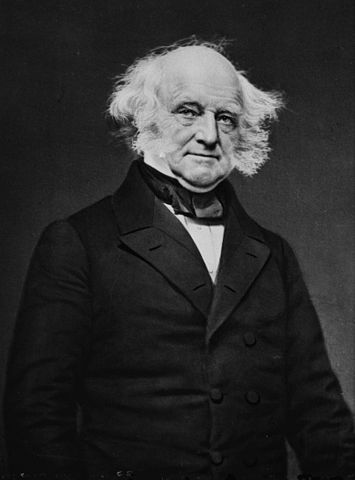Discussions about immigration are funny. They tend to focus on the same small handful of heartfelt pleas; arguments about losing our culture, griping that immigrants don’t learn the language (“the language” being English), and the idea that immigrants of the past used to come here and work hard to assimilate themselves into American culture.
As we’re about to discover, that last part is largely a myth.
First, a word on the language. The United States has no official language. Never has. As immigration has increased from non-European countries, there have also been increasing calls for a national language, thus far to no avail.
Some individual states do, 32 of them in all, but not the United States itself. Our documents are written in English, and that makes sense for reasons we shouldn’t have to outline here, but the federal government does not recognize an official language.
So scratch that one off the list. There is no legal obligation to speak English.

German Immigrant Centennial Monument in Landa Park, New Braunfels, Texas. Photo by Larry D. Moore CC BY-SA 4.0.
Still, the idea that there are people in the country who speak a language other than English as their primary language really bothers some people. Much ado is made about the fact that in 1 in 5 American households, English is not the primary language spoken. That feels awfully significant, doesn’t it, as if it signals the beginning of the end of American culture?
Yet take a jaunt through history and you learn that not only is this not all that unusual, the idea of bringing your culture along with you when you arrive is decidedly American in nature. It’s something immigrants to the U.S. have been doing for centuries. It’s part of the cultural fabric of the United States.
Just like today, though, there were naysayers.
Among the first groups to cause a minor uproar over not assimilating “properly” are a group that may come as a surprise: the Germans.
German immigrants were once common, and unsurprisingly, they spoke German as their primary language. They also made no effort to assimilate when they arrived here. In spots through the country, notably in Pennsylvania, Wisconsin, and spots throughout the so-called Rust Belt, they created their own communities in which people spoke German, embraced and promoted German culture, and generally lived what seemed like a life apart from other Americans.
This was not uncommon, either. In fact, at one time, a large number of American school children received their education almost exclusively in German (close to 10% according to some sources). English was not spoken in their classrooms. It’s not true that German almost became the U.S.’s official language – that’s a widely believed myth – but it is true that German immigrants have a long history of saying, “We’re going to do our own thing.”
This was common enough so that for many years, German was the second most widely spoken language in the United States. School, churches, newspapers, businesses: countless operated in German rather than English. There was even one Wisconsin town where people didn’t start learning English for five generations, right up until 1910, and even then only as a second language.
Albert Bernhardt Faust wrote in 1909 that “every American city or town with a large German population possesses one or more German newspapers. In New York City there are twelve or more.” In the year 1900, there were over 600 German language newspapers being printed in the United States.
The reaction to this sometimes mirrored today’s reaction to Hispanic immigrants. In the days following World War I, harassment of Germans was not uncommon. There were efforts to get them to assimilate, to shame them, to shun them, and so on.
The remnants of these German enclaves still exist throughout the country. German is actually still spoken today as a primary language in a surprising number of places in the U.S.
Today, we’re sold on the myth that in the past immigrants would come here, learn the language, and become “real Americans,” but clearly these German immigrants were not assimilating. At least, not in the way we now demand immigrants assimilate.
In fact, immigrants doing their own thing, English be damned, has been common among most groups to come to the U.S.
It’s no coincidence that major cities, especially those in the east, are or have been divided into ethnic communities. New York’s Little Italy is world famous, and similar neighborhoods can be found in cities all over, including Cleveland and Chicago. These neighborhoods weren’t created as tourist traps, places for Italian restaurants could group together. They were created because immigrants chose to live together in communities that felt as close to their home country as possible. People in these Little Italys spoke Italian (and Sicilian). They were in no rush to learn English; that was something for their kids to worry about.
Italian would probably be more widespread today, except that during World War II we sometimes rounded up Italians and seized their property (<–PDF) and discouraged the use of the language.
Elsewhere in the country, such as in New Orleans, you’d have whole communities where French was heard just as often as English. In other large cities and on the west coast, Chinatowns formed as Chinese immigrants were brought over as cheap labor for the Transcontinental Railroad. Irish immigrants came in several waves, especially after the Great Famine, and formed Irish ethnic ghettos in major American cities, notably in New York and Philadelphia – and yes, they spoke Irish, conducted business in Irish, and even had Irish newspapers, at least one of which survives to this day as a magazine. And so on.
Back in 2002, I wrote a three-part story about a tiny section of Jackson, NJ called Cassville. Today it’s just another extension of Jackson’s swelling suburbia, but in years past it was a Russian enclave. Decidedly Russian Orthodox, here Russian immigrants gathered, built lives, worshiped, and created a community together. And yes, they embraced their Russian-ness, both culturally and linguistically.
Hell, we once elected a president whose native language was not English. Yep, it’s true. Martin Van Buren, the eight President of the United States, was a native Dutch speaker. English was his second language. He came from a small town called Kinderhook in New York, and there people mainly spoke Dutch, “the language that prevailed for many generations in that part of New York State along the Hudson River.”
And for the record, yes, there were absolutely immigrant families who worked hard to learn the language and become “real Americans,” just as there are today. Depending on where you lived, at least some grasp on English may have been necessary for the basics. Again, just as it is today. Yes, you may have had family members who did try their hardest to assimilate upon arriving. Yet again, it happens today, too. My point throughout this piece isn’t that it never happened — it did then, and does now — it’s that we’ve mythologized past immigration in a way that paints an inaccurate picture of how it often played out. We now claim that past immigrants were always eager to be all mom and apple pie, but history tells us otherwise.
German. Dutch. French. Italian. Chinese. Irish. Communities in which English is often a second language have been common throughout our history. Hints of it remain in our country today. There 21 counties where more than 10 percent of the population speak German at home, plus 15 counties where French is the primary home language, and others. Check out the map here. There are even still many households where Italian is the daily language spoken, though that number is shrinking.
Yes, Spanish obviously dominates the map above, but aside from that being a big “so what?” it’s also not something to worry about for reasons we’ll get to below.
And make no mistake, multi-lingual communities exist in other countries, too. If you move to Spain, the common argument for forcing immigrants to assimilate goes, you have to speak Spanish.
Not so fast, partner. Even in Spain, the place where the Spanish language was born, there are a number of languages spoken in Spanish households. Spanish (Castilian) is the most common and official language in Spain, but Galician- Portuguese, Basque, Catalan and Occitan (aranès) are all spoken in Spanish homes.
Here in the States, we worry about people not speaking English. Fear of people coming into the country and not speaking English is as old as the hills. Read this and try to figure out if it was said in the ‘50s, ‘60s, ‘70s or ‘80s:
“Few of their children in the country learn English… The signs in our streets have inscriptions in both languages … Unless the stream of their importation could be turned they will soon so outnumber us that all the advantages we have will not be able to preserve our language, and even our government will become precarious.”
This was written in the ‘50s.
The 1750s, by Benjamin Franklin.
But if all of this is true, wouldn’t that mean that immigrants would never assimilate? How come Italian-Americans now speak English, German-Americans now speak English, and so on?
Because immigrants do assimilate, they just tend to do it naturally. You can’t force assimilation, nor should you. Immigrant families turn into American families by living the American experience, good or bad. It happens all on its own. Typically, it’s second generation immigrants who are the ones who adopt English as their primary language, socialize outside their ethnic group, and who more fully think of themselves as a typical American.
The fear that waves of immigrants will swarm the country and a generation later we’ll be speaking Insert The Language You Fear Here is unfounded. Research shows that America is the Borg; resistance is futile. The children of immigrants, and especially the grandchildren, will be assimilated.
What is driving that fear right now? Why are we in a tizzy over immigration?
Few people like to acknowledge it, many will outright deny that it’s a factor, but research shows that there is a clear racial element to our feelings about immigration. Basically, Americans worry about immigrants if they are Hispanic/Latino, African, or from the Middle East, and mostly don’t care about other immigrants. It’s not the only factor, to be sure – I wouldn’t want to paint with such a broad brush, and no, I’m not calling you a racist – but the evidence that it’s a larger factor than we care to acknowledge is undeniable:
About (40% of) Americans say the impact of immigrants from Latin America and the Middle East has been mostly negative…
The most positive reviews are reserved for Asian and European immigrants. According to the survey, 47% of U.S. adults say the impact of Asian immigrants on American society has been mostly positive, just 11% say their impact has been mostly negative and 39% say it has been neutral. When asked about the impact of European immigrants, views are similarly positive. Some 44% of U.S. adults say European immigrants’ impact on American society has been mostly positive, 9% say it has been negative and 45% say it has been neither.
So a very small minority of Americans see Asian and European immigration as a bad thing, just 11 and 9 percent, respectively, but a whopping 40% see immigration from Latinos and Middle Easterners as a bad thing – and remember, those numbers include Latino and Middle Easterner respondents, which means among whites the “negative” respondents is actually higher than the cited number.
There are many people in denial about the racial aspect of immigration opposition, but the disparity in the numbers is impossible to ignore.
Like most race-based fears, however, there just isn’t a lot there to support them. Some call Hispanic immigrants the new Italians, people who come here a step behind in wealth and language, who form supportive communities and work hard, and who are well on their way to becoming just as “invisible” as previous immigration waves. Hell, in 2013, Hispanic high school graduates were more likely to enroll in college than whites. Sure sounds like a group of people who are pursuing the American dream.
Oh, and those fears about today’s immigrants creating waves of crime? Despite the memes your cousin has shared, immigrants are less likely to commit crimes than U.S. citizens. Further, crime rates have fallen even as illegal immigration has increased, indicating that fears about illegals causing a crime wave are unfounded, too. This Washington Post piece cites a slew of studies that all come to the same conclusion.
Despite the waves of anti-immigrant hysteria we’re feeling right now, hysteria that is likely to increase in the years ahead, the truth is that immigration today is little different than immigration of yesteryear, except perhaps for how the immigrants look. They come. They work. Their kids go to school with your kids. And both your kids’ kids look back and wonder what all the fuss was all about.
This is how it’s always been. It’s not a new phenomenon. The United States has had waves of immigrants of many ethnicities, from the varied hues of white (German, Dutch, Irish, French) to Italians, Chinese, Pacific Islanders, and Latinos and Hispanics of all stripes, and you know what?
They’re all Americans.
No one forced them to “learn the language and become American,” and by and large they didn’t. That’s a myth. It’s also a stupid, realistic expectation, because almost no one becomes fluent in a new language in adulthood. You can learn enough to get by, which is what most immigrants who don’t natively speak English do — there are very few immigrants who can’t speak or understand English at all, a mere 6 percent of immigrants who have lived in the U.S. for some time — but fluency? That comes when you’ve been learning a language since your youth.
And in fact, a recent study shows that today’s Latino immigrants are learning English far faster than immigrants of the past.
Today, 92 percent of the Latino second generation (children of immigrants) speak English “very well,” and by the third generation nearly one hundred percent of Latinos are either English dominant or fully bilingual, according to a Pew study from last year.
In the late nineteenth century, in contrast, more than a third of all residents of Wisconsin were native German speakers, and in some counties, like Hustisford, Wisconsin, 35 percent of American-born (second generation) immigrants spoke only German.
Salmons says there are no Latino communities in the U.S. that mimic these patterns.
So that’s another argument to be tossed out the door.
This is all a bunch of been there, done that. Immigrants do now what they’ve always done in America: they gather together in communities where they feel comfortable and safe and are able to make the best of their new lives, and the generations that follow integrate themselves more fully into the wider American culture, enriching it with their own culture and experience as they do so.
That’s not something to fear, it’s something to embrace.










Great article. Another thing that I think bothers some “Americans” is that they think the immigrants are taking their jobs more now than ever. Of course if this was a fallacy (which may not be in some cases perhaps) it could derail the whole argument, but from my experience Americans AKA white people this is not the case. Maybe in larger cities hispanics take up the bigger percentage in the lower level jobs like construction and the hotel service industry (like my parents). Some of the figures may also be unreliable because some hispanic immigrants may not be citizens or residents which also infuriates the Natural Borners. Thank you.